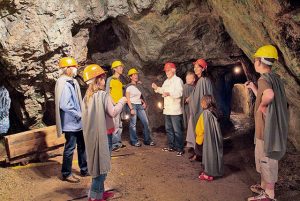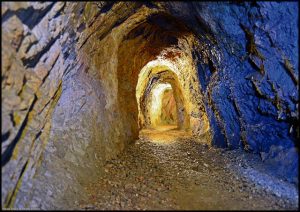
A tour guide gives explanations in the White Mine in Imsbach. English-guided tours are being offered from 11 a.m. to 5 p.m. Sunday.
In the Palatinate, the mining tradition is very old because a great variety of natural resources were found here. In some areas, there is even evidence of mining activities dating back to the time of the Celts.
The small town of Imsbach, located in the foothills of the Donnersberg, used to be a mining town. Even today, visitors can see traces of the early mining activities and travel back through time by exploring the two mines, “Weisse Grube,” meaning “white mine,” and Maria.
The Historic Museum of Mining in the Palatinate does not only display an extensive collection of beautiful minerals but also other natural resources that were found in the region.
The Mining World of Imsbach will again offer guided tours in English this season. Officials hope to accommodate American community members with these special tours through the Weisse Grube that will be offered from 11 a.m. to 5 p.m. Sunday, July 17 and Sept. 25.
Tickets are € 4 for adults and € 2 for children and include the guided tour as well as admittance to the mining museum. Reservations are not required.

The Mining World in Imsbach is worth a trip to experience traces of early mining activities.
This year’s season will close at the end of October. Opening hours are 1 p.m. to 5 p.m. Saturdays and 10 a.m. to 5 p.m. Sundays and German holidays, with regular guided tours in German. Groups of at least 15 can make reservations for guided tours during weekdays.
There are also three historic hiking routes that run through the forests of Imsbach. Numerous signs alongside the paths explain the town’s mining history. These routes can be explored year-round and during guided tours that are offered on special dates.
For more information, call the Winnweiler Tourist Information office at 06302-602-61, email info@winnweiler-vg.de or visit www.bergbauerlebniswelt-imsbach.de.


